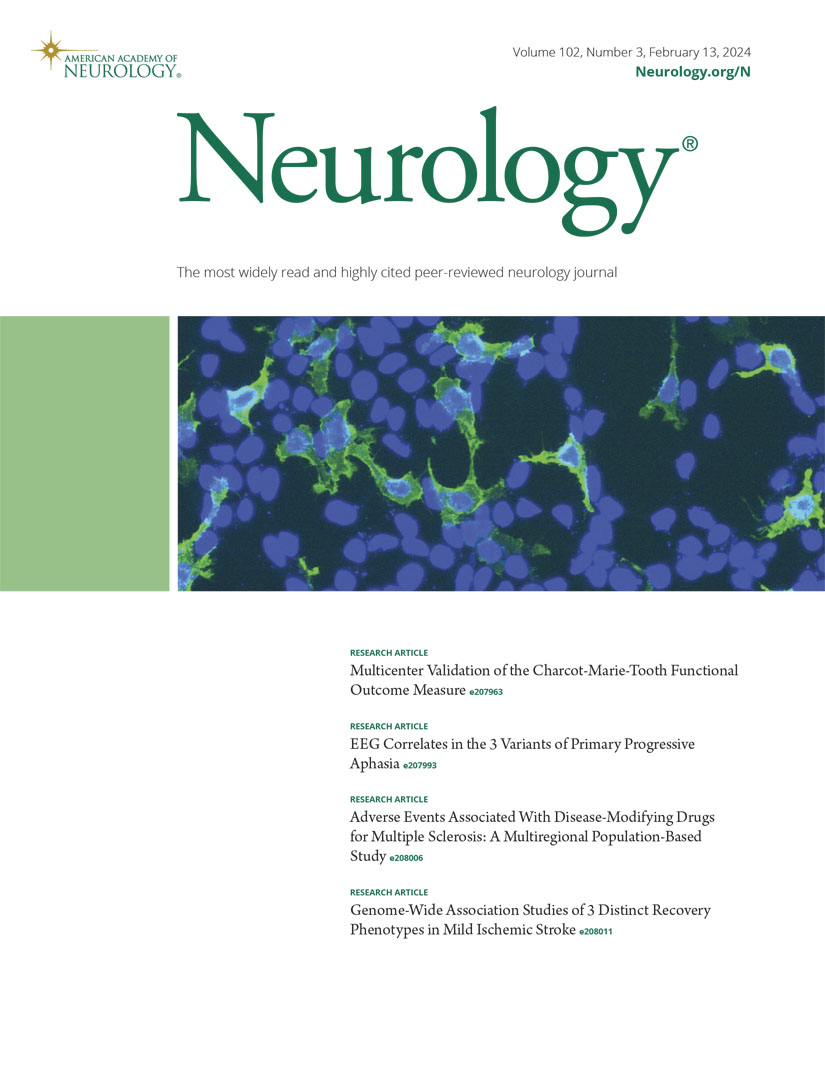Association Between Metabolic Syndrome and Young-Onset Dementia: A Nationwide Population-Based Study.
IF 7.7
1区 医学
Q1 CLINICAL NEUROLOGY
引用次数: 0
Abstract
BACKGROUND AND OBJECTIVES Young-onset dementia (YOD) poses substantial societal and health care burdens. Although metabolic syndrome (MetS) is recognized as a contributor to late-onset dementia, its effect on YOD remains unclear. This study aimed to determine whether MetS and its individual components increase the risk of YOD, including all-cause dementia, Alzheimer disease (AD), and vascular dementia (VaD). METHODS We conducted a nationwide population-based cohort study using data from the Korean National Insurance Service. Individuals aged 40-60 who underwent national health check-ups in 2009 were included and followed until December 31, 2020, or age 65, whichever came first. MetS was defined according to established guidelines, incorporating measurements of waist circumference, blood pressure, fasting glucose, triglycerides, and high-density lipoprotein cholesterol. Covariates included age, sex, income level, smoking status, alcohol consumption, and comorbidities such as hypertension, diabetes, dyslipidemia, and depression. The primary outcome was incident all-cause YOD, defined as a dementia diagnosis before age 65; secondary outcomes included young-onset AD and VaD. Multivariable Cox proportional hazards models were used to estimate hazard ratios (HRs) with 95% CIs. RESULTS A total of 1,979,509 participants (mean age, 49.0 years; 51.3% men; 50.7% with MetS) were included. Over an average follow-up of 7.75 years, 8,921 individuals (0.45%) developed YOD. MetS was associated with a 24% higher risk of all-cause YOD (adjusted HR 1.24, 95% CI 1.19-1.30), a 12.4% increased risk of AD (HR 1.12, 95% CI 1.03-1.22), and a 20.9% increased risk of VaD (HR 1.21, 95% CI 1.08-1.35). Significant interactions were noted with younger age (40-49 vs 50-59), female sex, drinking status, obesity, and depression. DISCUSSION In this large Korean cohort, MetS and its individual components were significantly associated with an increased risk of YOD. These findings suggest that interventions targeting MetS may help mitigate YOD risk. However, the observational design precludes definitive causal inferences, and reliance on claims data could introduce misclassification bias. Future research using longitudinal designs and comprehensive data collection is needed to validate and expand on these associations.代谢综合征与年轻发病痴呆之间的关系:一项基于全国人群的研究。
背景与目的年轻发病痴呆(YOD)造成了巨大的社会和医疗负担。虽然代谢综合征(MetS)被认为是迟发性痴呆的一个因素,但其对YOD的影响尚不清楚。本研究旨在确定MetS及其个体成分是否会增加YOD的风险,包括全因痴呆、阿尔茨海默病(AD)和血管性痴呆(VaD)。方法:我们使用韩国国民保险公团的数据进行了一项基于全国人群的队列研究。纳入了2009年接受过全国健康检查的40-60岁的个人,并随访至2020年12月31日或65岁,以先到者为准。MetS是根据既定的指南定义的,包括腰围、血压、空腹血糖、甘油三酯和高密度脂蛋白胆固醇的测量。协变量包括年龄、性别、收入水平、吸烟状况、饮酒和合并症,如高血压、糖尿病、血脂异常和抑郁症。主要结局为偶发性全因YOD,定义为65岁前的痴呆诊断;次要结局包括年轻发病的AD和VaD。多变量Cox比例风险模型用于估计95% ci的风险比(hr)。结果共纳入受试者1,979,509人(平均年龄49.0岁;男性51.3%;50.7%为MetS患者)。在平均7.75年的随访中,8,921人(0.45%)出现了YOD。MetS与全因YOD风险增加24%相关(调整后危险度1.24,95% CI 1.19-1.30), AD风险增加12.4%(危险度1.12,95% CI 1.03-1.22), VaD风险增加20.9%(危险度1.21,95% CI 1.08-1.35)。年龄较小(40-49岁vs 50-59岁)、女性、饮酒状况、肥胖和抑郁之间存在显著的相互作用。在这个庞大的韩国队列中,MetS及其个体成分与YOD风险增加显著相关。这些发现表明,针对MetS的干预措施可能有助于降低YOD风险。然而,观察性设计排除了明确的因果推断,对索赔数据的依赖可能会引入误分类偏差。未来的研究需要使用纵向设计和全面的数据收集来验证和扩展这些关联。
本文章由计算机程序翻译,如有差异,请以英文原文为准。
求助全文
约1分钟内获得全文
求助全文
来源期刊

Neurology
医学-临床神经学
CiteScore
12.20
自引率
4.00%
发文量
1973
审稿时长
2-3 weeks
期刊介绍:
Neurology, the official journal of the American Academy of Neurology, aspires to be the premier peer-reviewed journal for clinical neurology research. Its mission is to publish exceptional peer-reviewed original research articles, editorials, and reviews to improve patient care, education, clinical research, and professionalism in neurology.
As the leading clinical neurology journal worldwide, Neurology targets physicians specializing in nervous system diseases and conditions. It aims to advance the field by presenting new basic and clinical research that influences neurological practice. The journal is a leading source of cutting-edge, peer-reviewed information for the neurology community worldwide. Editorial content includes Research, Clinical/Scientific Notes, Views, Historical Neurology, NeuroImages, Humanities, Letters, and position papers from the American Academy of Neurology. The online version is considered the definitive version, encompassing all available content.
Neurology is indexed in prestigious databases such as MEDLINE/PubMed, Embase, Scopus, Biological Abstracts®, PsycINFO®, Current Contents®, Web of Science®, CrossRef, and Google Scholar.
 求助内容:
求助内容: 应助结果提醒方式:
应助结果提醒方式:


